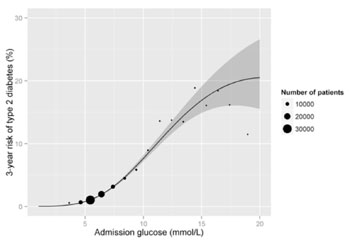Blood Glucose in Hospitalized Patients Predicts Diabetes Risk
By LabMedica International staff writers
Posted on 03 Sep 2014
Blood glucose levels measured in hospitalized adults during acute illness can be used to predict the risk of developing type 2 diabetes over the following three years. Posted on 03 Sep 2014
Many patients admitted to hospital because of an acute illness have hyperglycemia, an abnormally high blood glucose level which can be caused by the drugs that patients are taking for existing conditions or may be stress hyperglycemia.

Image: The three year risk of type 2 diabetes by admission glucose. The solid line represents the estimate and the ribbon represents the 95% confidence intervals (Graph courtesy of the Public Library of Science).
Scientists at the University of Edinburgh (UK) carried out a retrospective cohort study on patients aged 30 years or older with an emergency admission to hospital between 2004 and 2008. They obtained measurements of blood glucose levels on admission for 86,634 patients who were admitted to a hospital for an acute illness and identified those patients who developed type 2 diabetes up to December 2011.
The investigators found that the overall three year risk of developing type 2 diabetes was 2.3%, with the risk of developing diabetes increased linearly with increasing blood glucose level at admission. The three year risk of type 2 diabetes was 1% for patients with a glucose level of less than 5 mmol/L (90 mg/dL) and increased to approximately 15% for patients with glucose of 15 mmol/L (270 mg/dL) or more. The team developed a risk calculator that uses the patient's age, sex, and admission blood glucose level to predict risk of developing diabetes over three years following hospital admission.
The scientists confirm that single measures using the WHO cut-points for diagnosing diabetes, which are not based upon studies that measured glucose in the emergency setting cannot be directly applied in acutely unwell patients with hyperglycemia. They found that 90% of patients with admission glucose of 11.1 mmol/L (200 mg/dL) were not diagnosed with diabetes within three years of discharge from the hospital.
The authors conclude that the three year risk of type 2 diabetes was less than 1% for patients with a glucose of less than or equal to 5 mmol/L and increased linearly to approximately 15% at 15 mmol/L, above which there was no further increase in risk. Mortality was also 1.5-fold higher in patients with glucose levels of 11.1 to 15 mmol/L compared to those with glucose levels less than 6.1 mmol/L. These findings can be used to inform individual patients of their long-term risk of type 2 diabetes and to offer lifestyle advice as appropriate. The study was published on August 19, 2014, in the journal Public Library of Science Medicine.
Related Links:
University of Edinburgh














